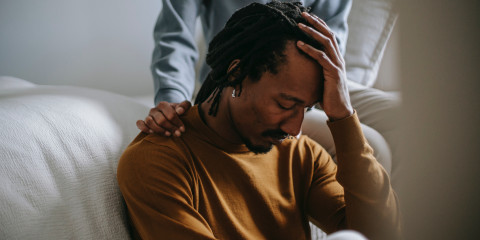Depression is a relatively common and widespread mental disorder. It is estimated to affect around 3.8% (approximately 299 million people) of the global population with 5% of all adults and 5.7% of individuals above 60 years suffering from the condition (WHO, 2021). Depression is defined as a mood disorder characterized by a prolonged and persistent feeling of sadness with a general loss of interest in routine activities. However, it should not be confused with mood changes that we experience in our day-to-day lives. The most common classifications of depression include clinical depression mainly caused by several sources of distress; persistent depressive disorder which is a considerably mild but persistent form of depression; bipolar disorder indicated by episodes of severe depressive lows and manic high mood swings; and postpartum depression which usually takes place after childbirth.
Depression is not a one size fits all mental condition, it can manifest itself in different ways from one individual to another. Nevertheless, there are several signs and symptoms that one can look out for. These symptoms include persistent feelings of extreme sadness, hopelessness, tearfulness, emptiness, significant loss of pleasure and interest in nearly all activities one once enjoyed, changes in sleeping patterns which could include insomnia or oversleeping, shifts in eating patterns and appetite that could cause weight loss or gain, anxiety together with agitations which may be expressed through irritability, frustration and angry outbursts even over very small issues. Additionally, depression can also be exhibited by problems in concentration, decisiveness, memory issues, feelings of guilt, self-blame, feelings of worthlessness, fixation on past shortcomings or failures, increased fatigue, tiredness and lack of energy to do even relatively small tasks and activities. Finally, in the most severe cases depression graduates to thoughts of harming oneself through the harboring of suicidal thoughts together with recurrent suicidal attempts. Nonetheless, for an individual to be correctly diagnosed as being depressed, these symptoms need to be witnessed or experienced for at least two weeks while adversely interfering with the normal routine functioning of the individual.
Understandably, there is a wide range of causes of depression and various risk factors that might make one prone to depression. Depression can stem from one’s family history where if, a certain family member has suffered from depression the individual might develop depressive tendencies through learned behavior or biology. Health issues can also increase the likelihood of depression manifesting. Physical illness, injuries, chronic or long-term health issues can also be risk factors leading to depression. This is because they severely and negatively change an individual’s lifestyle rendering one psychologically overwhelmed. Certain medication, recreational drugs and alcohol can promote depression since they alter normal functioning and brain chemistry. Unpleasant life events could also increase the risks of suffering from depression. For example, the loss of a job or prolonged unemployment; stress at the workplace; going through a breakup, divorce, being in a dysfunctional relationship and grieving a loved one. Additionally, personality plays a significant role in an individual’s depression vulnerability. People with low self-esteem, pessimistic tendancies or ineffective stress handling techniques might experience depression. Finally, exposure to certain environmental factors such as social isolation, neglect, abuse, violence and poverty may make an individual more vulnerable to depression (CDC, 2022).
Fortunately, there are some highly effective treatment methods and responses that can be used to treat depression. Between 80% and 90% of all patients under these treatments respond well in the long rung while almost all of them acquire significant relief from the symptoms (WHO, 2021). The treatment might be in the form of medication and/or psychotherapy. For medication, a patient is prescribed different antidepressants that help modify the patient’s brain chemistry and discourage depressive tendencies. Psychotherapy is used alone for mild cases or with antidepressant medication in severe or moderate cases. It involves one-to-one counselling with a psychologist using various forms of therapy. The therapy session focuses on solving present problems by recognizing the source of negative thoughts or behaviors and finding ways of changing them and positively responding to challenges. Click here to find a psychologist. Finally, in severe cases, Electroconvulsive Therapy (ECT) is used to treat depression. It involves a short electrical stimulation of the patient’s brain under anesthesia to positively alter the makeup of the brain structure and treat depression.
In summary, depression affects a significant portion of the global population. If we are keen enough, we can detect the signs and symptoms in ourselves or our loved ones. Seeking treatment at early stages prevents the progression of the illness to severe stages. Luckily, various highly effective treatments can be applied or combined to counter this. Further, we can all apply various tried and tested self-help and coping techniques such as regular exercise, adequate quality sleep, healthy dieting and avoiding triggers such as recreational drugs and alcohol. Depression is a real illness but we can all overcome it to live fruitfully, fulfilling and happy lives.
Reference
CDC (2022). Mental Health Conditions: Depression and Anxiety. Centers for Disease Control and Prevention. https://www.cdc.gov/tobacco/campaign/tips/diseases/depression-anxiety.html
WHO (2021). Depression. World Health Organization. https://www.who.int/news-room/fact-sheets/detail/depression

 By Brenda Onyango
By Brenda Onyango






Comments (34)
yvQIsTCfAL
yvQIsTCfAL
EDBLJozjAcZQ
EDBLJozjAcZQ
NfyIzRQux
NfyIzRQux
nXFwCJrkSfpIiLvq
nXFwCJrkSfpIiLvq
prhedUzRLH
prhedUzRLH
EZYQHmCgdrOix
EZYQHmCgdrOix
HzNKgQoe
HzNKgQoe
LYMsoQyq
LYMsoQyq
LYMsoQyq
iAgETODukWv
iAgETODukWv
iAgETODukWv
SuDilyCvf
SuDilyCvf
RwKAgeiPpdSV
RwKAgeiPpdSV
RwKAgeiPpdSV
MfSaBKmrcoANi
MfSaBKmrcoANi
MfSaBKmrcoANi
vWlgTrMEomjKVcRN
vWlgTrMEomjKVcRN
vWlgTrMEomjKVcRN
fMSUXdZQz
fMSUXdZQz
fMSUXdZQz